Spectacular images depicting phenomena ranging from the aurora borealis at night time to the Milky Way reflected in the Snake River in Wyoming are among just a few to be shortlisted for the Astronomy Photographer of the Year 2014 award. The competition, which is run by the Royal Observatory Greenwich in association with BBC Sky at Night Magazine, is now in its sixth year and has received over 2,500 entries.
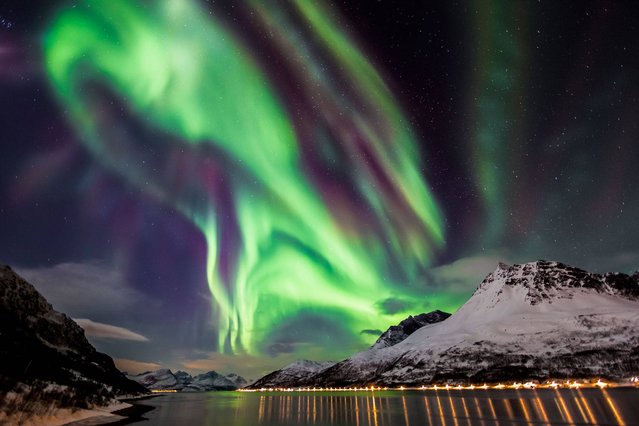
Celestial Dance by Claus Possberg (Germany). The spectacular Northern Lights pictured unfolding over a fjord, in Skjervøy, Troms, Norway. The vibrant colours are produced at various altitudes by different atmospheric gases, with blue light emitted by nitrogen and green by oxygen. Red light can be produced by both gases, while purples, pinks and yellows occur where the various colours mix and intersect. (Photo by Claus Possberg)
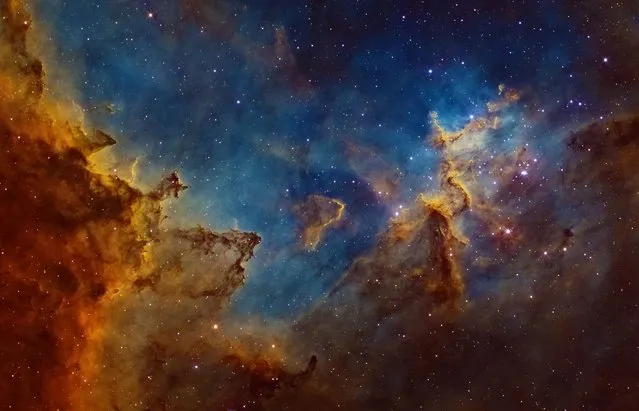
Centre of the Heart Nebula by Ivan Eder (Hungary). Situated 7500 light years away in the “W”-shaped constellation of Cassiopeia, the Heart Nebula is a vast region of glowing gas, energized by a cluster of young stars at its centre. The image depicts the central region, where dust clouds are being eroded and moulded into rugged shapes by the searing cosmic radiation. (Photo by Ivan Eder)
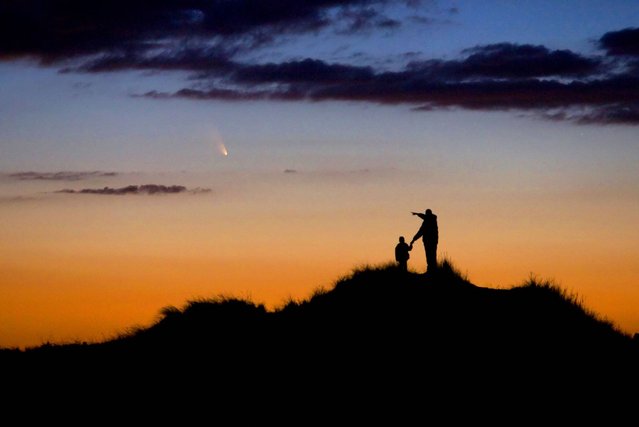
Father and Son Observe Comet PanSTARRS by Chris Cook (USA). A father and his young son watch the evening display of Comet PanSTARRS on First Encounter Beach, Eastham, Massachusetts, USA. The photographer had spent weeks preparing the shoot to capture the comet, which will not be seen again for over 100,000 years, in order to foster his son’s interest in astronomy. (Photo by Chris Cook)
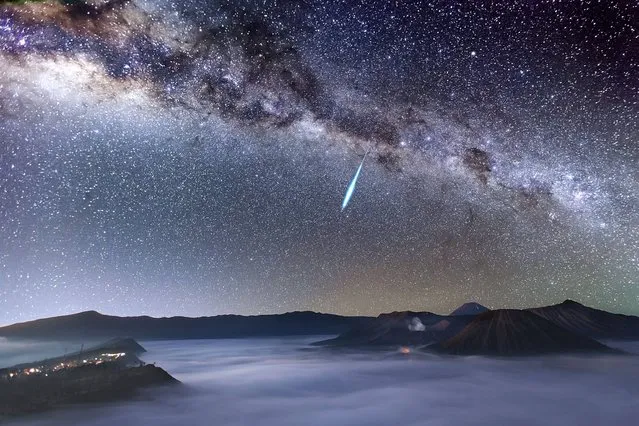
Eta Aquarid Meteor Shower over Mount Bromo by Justin Ng (Singapore). A bright meteor streaks across the magnificent night sky over the smoke-spewing Mount Bromo just one day before the peak of the Eta Aquarid meteor shower, which is caused by Halley’s Comet. Mount Bromo is one of the most well-known active volcanoes in East Java, Indonesia. Also seen in the photograph are the highest active volcano, Mount Semeru (3676m), and the extinct volcano, Mount Batok, which is located to the right of Mount Bromo. (Photo by Justin Ng)
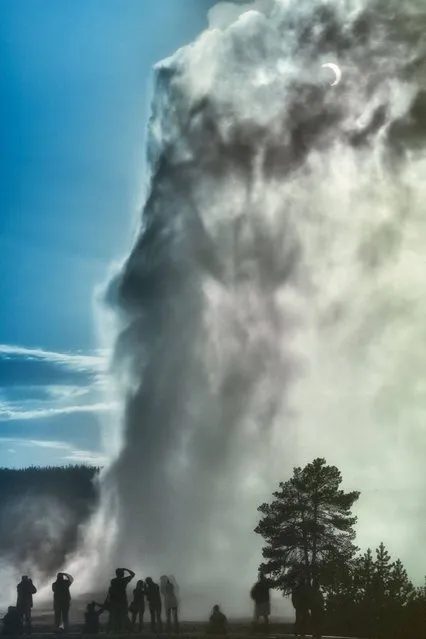
Eclipse and Old Faithful by Robert Howell (USA). Visitors witness the Old Faithful geyser in Yellowstone National Park erupt as the Moon partially eclipses the Sun. The scene captures a sense of awe set against blue sky and white geyser steam, as the onlookers strain to see the joining of these two phenomena – one geological and one astronomical. (Photo by Robert Howell)
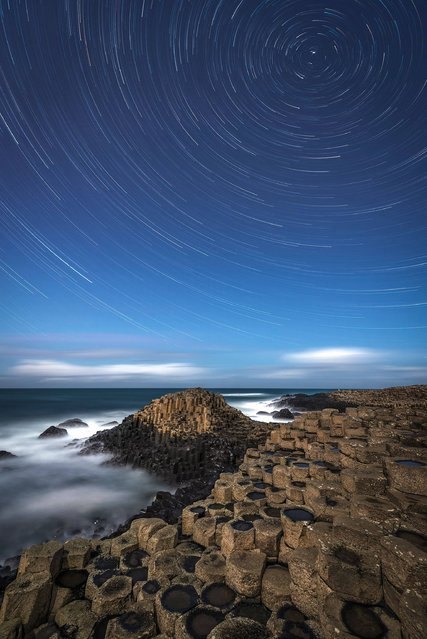
A Giant's Star Trail by Rob Oliver (UK). A composition of several images taken at the famed Giant’s Causeway in Northern Ireland. Our planet’s rotation draws the stars out into circles – considered to be the most perfect shape by ancient philosophers. Separated from the sky by the stark line of the horizon, the atomic symmetries of crystallized rock display themselves in the hexagonal columns of the Giant’s Causeway. (Photo by Rob Oliver)
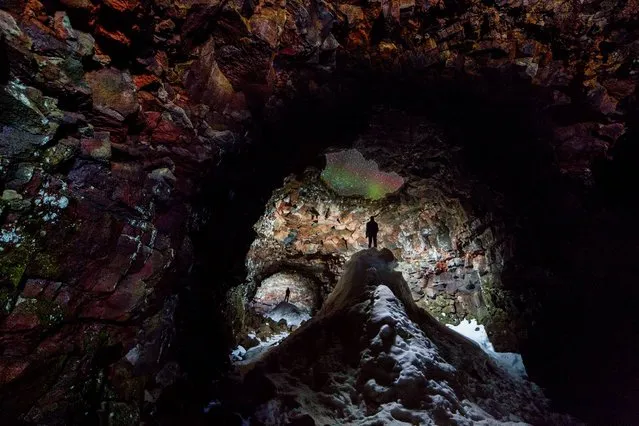
Cave With Aurora Skylight by Ingólfur Bjargmundsson (Iceland). This image was taken while exploring a 1300m lava cave in Iceland. In some areas the roof has caved in, so snow piles up in the winter time and creates these snow peaks. The aurora at its peak gleams through the roof of the cave and despite only taking up a small portion of the photo, it remains the focal point. (Photo by Ingólfur Bjargmundsson)
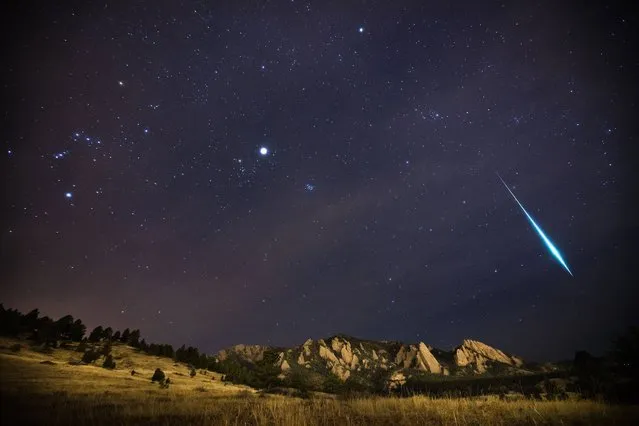
Geminid Fireball by Patrick Cullis (USA). The Geminid meteor shower races over the Flatirons of Boulder, Colorado, in December 2012. Here, a larger than usual fragment burns bright enough to outshine all of the planets, producing what is commonly called a Fireball. Orion can also be seen in the photograph trailing across the sky toward the Pleiades and the glow of Jupiter inside the constellation of Taurus. (Photo by Patrick Cullis)
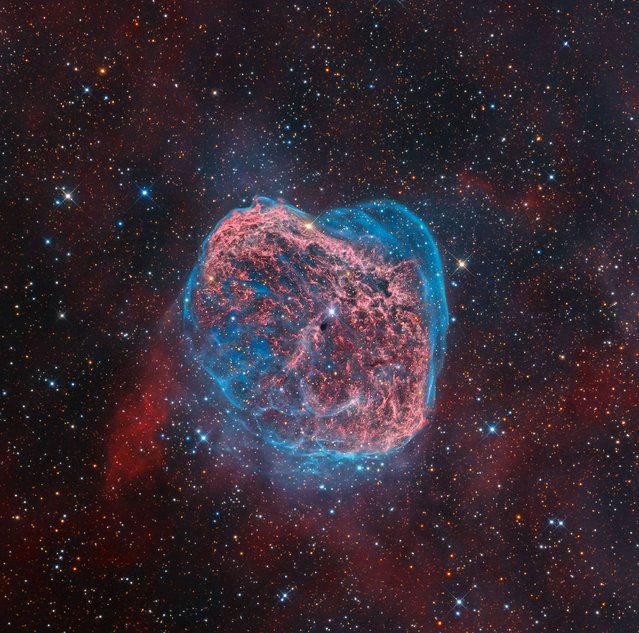
NGC 6888 by Mark Hanson (USA). This colourful starscape taken from Rancho Hidalgo, New Mexico, USA reveals the searing heat of the Crescent Nebula glowing in a whirl of red and blue. The emission nebula is a colossal shell of material ejected from a powerful but short-lived Wolf-Rayet star (WR 136), seen close to the image centre. Ultraviolet radiation and stellar wind now heats the swelling cloud, causing it to glow. (Photo by Mark Hanson)
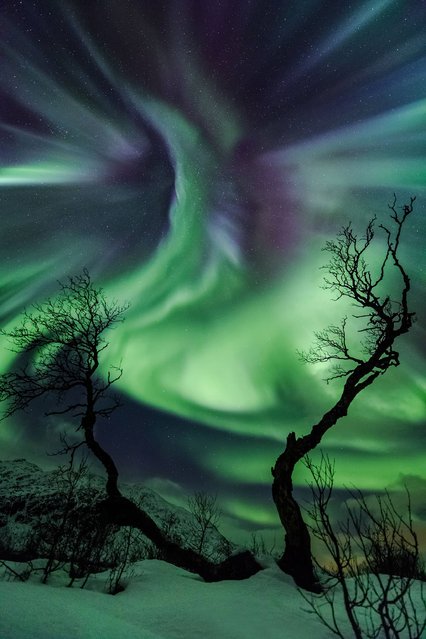
Creature by Ole Christian Salomonsen (Norway). On 30 October a CME (Coronal Mass Ejection) hit Earth, displaying multi-coloured auroras across the sky for most of the night in Kattfjordeidet, Tromsø, Norway. The old birch trees resemble arms reaching for the auroral corona appearing like a strange creature in the sky. (Photo by Ole Christian Salomonsen)
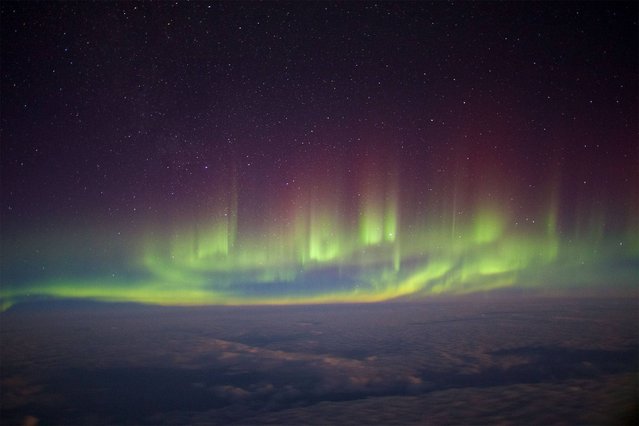
In-flight Entertainment by Paul Williams (UK). Resplendent aurora seen from the window of a transatlantic flight between London and New York in February 2014. The photographer balanced his camera on his backpack to capture this image of the greatest natural light show on earth from a rare perspective. (Photo by Paul Williams)
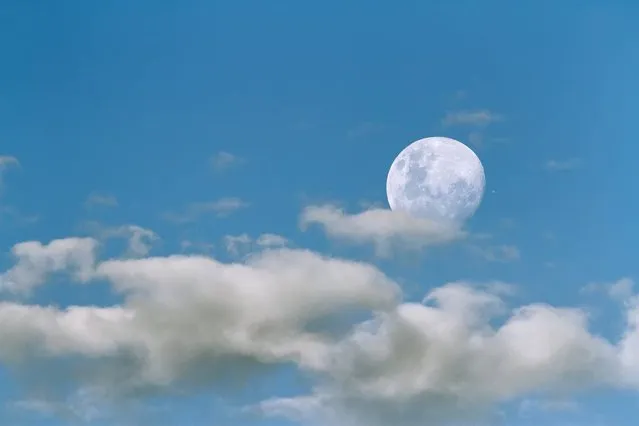
Occultation of Jupiter by Sebastián Guillermaz (Argentina). An unusual daytime view of an astronomical alignment, captured from the photographer’s backyard in Los Polvorines, Buenos Aires, Argentina. The image shows the moments just before the planet Jupiter is blocked from view by the Moon. The planet can be seen as a pale dot to the right of the Moon’s body. (Photo by Sebastián Guillermaz)
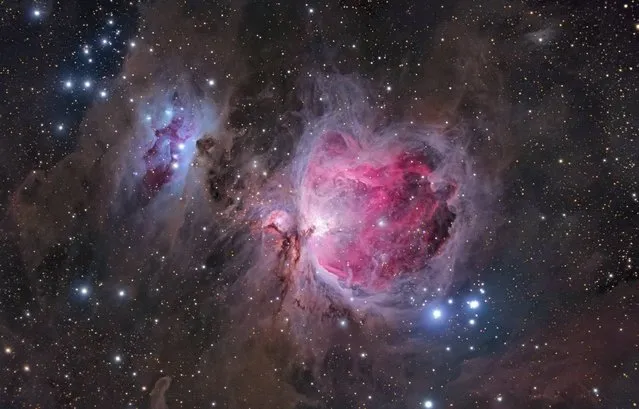
Orion Nebula by Anna Morris (USA). In this view of M42, more commonly known as the Orion Nebula, the photographer has emphasized the delicate veils of dust surrounding the more familiar gleaming heart of the nebula. The image highlights the structure of the object, giving a sense of vast cavities filled with pink hydrogen gas and the blue haze of reflected starlight. (Photo by Anna Morris)
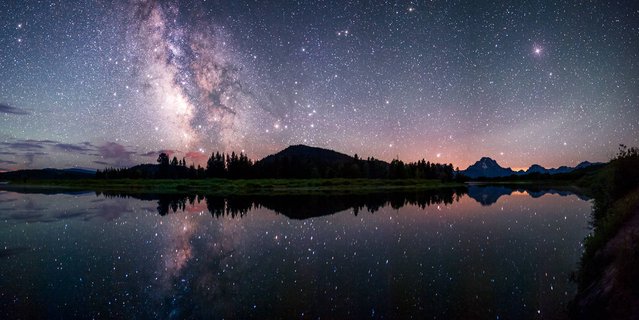
Oxbow Bend Reflections by David Kingham (USA). The Milky Way reflected in the Snake River at the famous Oxbow Bend in Grand Teton National Park. The galaxy is poised just above the horizon mimicking a glowing cloud. (Photo by David Kingham)
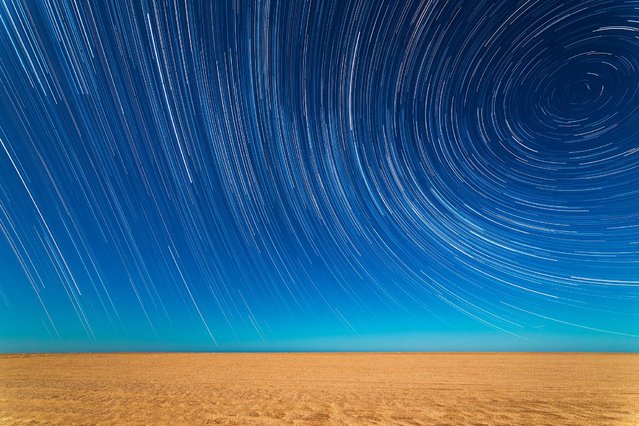
Star Trails on the Beach by Sebastián Guillermaz (Argentina). Multiple shots have been used to produce a time-lapse effect, as the Earth’s rotation draws the light from the stars into long trails arcing over the beach in Mar de Ajo, Buenos Aires Province, Argentina. (Photo by Sebastián Guillermaz)

The Great Orion Nebula by Gray Olson (USA). The sprawling stellar nursery of the Orion Nebula situated 1350 light years away and home to stars at diverse stages of their lives, captured by 15 year old Gray Olson. It is one of the brightest nebulae, and is even visible to the naked eye in the night sky making it a popular target for amateur astronomers. (Photo by Gray Olson)
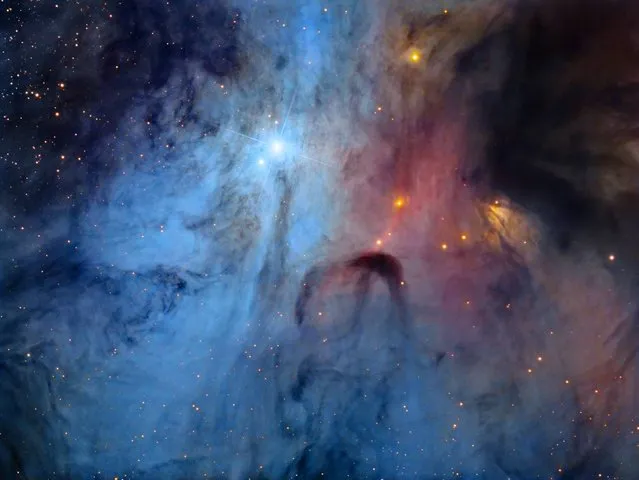
The Turbulent Heart of the Scorpion by Rolf Wahl Olsen (New Zealand). A spectacular display of light and shade with contrasting hues of the rarely imaged, colourful, action-packed core of the multiple star system, Rho Ophiuchi. A deep exposure showcases the full finery of the delicate whirling clouds, of an area in which the human eye would struggle to see much detail, even with the use of a telescope. (Photo by Rolf Wahl Olsen)
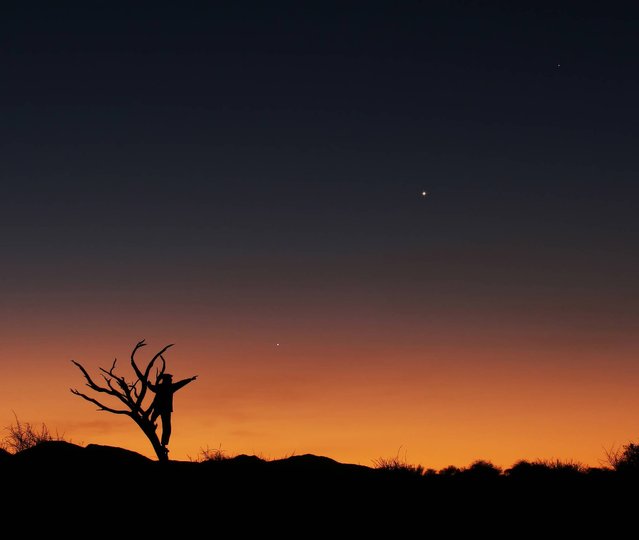
Three Planets in Conjunction by Lóránd Fényes (Hungary). The staggering colours of the sunset and flora of the African savannah afford a unique background for the planetary alignment of Jupiter, Venus and Mercury in June 2013. The golden hues of the sunrise, the three planets appeared as if they were strung on an invisible thread, and the bare tree and the human figure interwoven both point to one direction: Jupiter. (Photo by Lóránd Fényes)
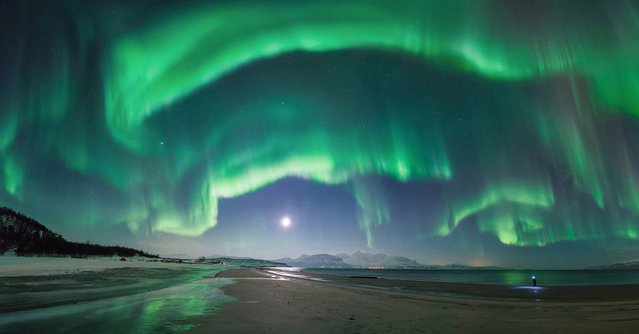
“What the...!” by Tommy Richardsen (Norway). A flamboyant flare up of the aurora over Steinsvik beach, in Nordreisa, Troms, Norway. It lasted no more than ten minutes from start to finish but it lit up the entire sky and took the photographer by surprise, just as he was about to leave the shoot. The figure on the right is his brother, furiously searching for his lens cap to capture the same phenomena. It was hard for the photographer not to laugh at his brother while moving the camera left to right capturing the panorama, but luckily he stood still long enough to make the final capture. (Photo by Tommy Richardsen)
03 Jul 2014 11:59:00,
post received
0 comments
